-
 Prospective Associations between Maternal Depressive Symptoms during Early Infancy and Growth Deficiency from Childhood to Adolescence
Prospective Associations between Maternal Depressive Symptoms during Early Infancy and Growth Deficiency from Childhood to Adolescence -
 Severe Post-COVID-19 Condition after Mild Infection: Physical and Mental Health Eight Months Post Infection: A Cross-Sectional Study
Severe Post-COVID-19 Condition after Mild Infection: Physical and Mental Health Eight Months Post Infection: A Cross-Sectional Study -
 Immediate Caregiving Environment of Young Children with Autism: Findings from the U.S. National Survey of Children’s Health
Immediate Caregiving Environment of Young Children with Autism: Findings from the U.S. National Survey of Children’s Health -
 Unlocking the WHO’s Age-Friendly Healthcare Principles: Portugal’s Quest and Recommendations
Unlocking the WHO’s Age-Friendly Healthcare Principles: Portugal’s Quest and Recommendations -
 A New Vision for IJERPH—A Transdisciplinary Journal of Environmental Research and Public Health
A New Vision for IJERPH—A Transdisciplinary Journal of Environmental Research and Public Health
Journal Description
International Journal of Environmental Research and Public Health
International Journal of Environmental Research and Public Health
is a transdisciplinary, peer-reviewed, open access journal published monthly online by MDPI. It covers Global Health, Healthcare Sciences, Behavioral and Mental Health, Infectious Diseases, Chronic Diseases and Disease Prevention, Exercise and Health Related Quality of Life, Environmental Health and Environmental Sciences. The International Society Doctors for the Environment (ISDE) and Italian Society of Environmental Medicine (SIMA) are affiliated with IJERPH and their members receive a discount on the article processing charges.
- Open Access— free for readers, with article processing charges (APC) paid by authors or their institutions.
- High Visibility: indexed within Scopus, PubMed, MEDLINE, PMC, Embase, GEOBASE, CAPlus / SciFinder, and other databases.
- Journal Rank: CiteScore - Q1 (Public Health, Environmental and Occupational Health)
- Rapid Publication: manuscripts are peer-reviewed and a first decision is provided to authors approximately 29.6 days after submission; acceptance to publication is undertaken in 3.9 days (median values for papers published in this journal in the second half of 2023).
- Recognition of Reviewers: reviewers who provide timely, thorough peer-review reports receive vouchers entitling them to a discount on the APC of their next publication in any MDPI journal, in appreciation of the work done.
- Testimonials: See what our editors and authors say about IJERPH.
- Sections: published in 38 topical sections.
Latest Articles
Changes in Sexual Behavior and Satisfaction and Violent Behavior during COVID-19 Lockdown: Explorative Results from the Italian Cross-Sectional Study of the I-SHARE Multi-Country Project
Int. J. Environ. Res. Public Health 2024, 21(1), 96; https://doi.org/10.3390/ijerph21010096 - 15 Jan 2024
Abstract
Background: The COVID-19 pandemic has had effects on sexual and reproductive health and intimate partner violence (IPV). This study aims to describe changes in sexual health and IPV in the Italian population both during and after the lockdowns. Methods: This cross-sectional online study
[...] Read more.
Background: The COVID-19 pandemic has had effects on sexual and reproductive health and intimate partner violence (IPV). This study aims to describe changes in sexual health and IPV in the Italian population both during and after the lockdowns. Methods: This cross-sectional online study was conducted, as part of the I-SHARE multicountry project, between June 2020 and January 2021. Recruitment was carried out through convenience sampling; a total of 329 participants were included in the analysis. A generalized linear model was used to analyze the difference in sexual health and IPV variables before, during, and after the lockdown. Results: Fifty-three percent of the participants reported having sexual problems during the first wave of the pandemic. Sexual satisfaction decreased during the first wave, and then, returned to the pre-lockdown level. While during the lockdown, some activities were reduced (such as kissing, cuddling, and sexual activities with a steady partner), for other activities, no difference was reported (such as masturbation, sexual activities with casual partners, or sexting). Few participants reported having issues accessing HIV testing and contraception. There was no difference in terms of physical and sexual violence, while there was a significant decrease in feeling vulnerable to sexual or physical assault during the first wave. Conclusions: The first wave of the pandemic has had significant effects on sexual health. This should be taken into consideration when preparing for future epidemics and health emergencies.
Full article
(This article belongs to the Special Issue Sexual Health and Sexual Behavior in the 21st Century)
Open AccessReview
Clinical Impact of “Real World Data” and Blockchain on Public Health: A Scoping Review
Int. J. Environ. Res. Public Health 2024, 21(1), 95; https://doi.org/10.3390/ijerph21010095 - 15 Jan 2024
Abstract
The digitisation of healthcare has allowed a significant rethinking of the previous clinical protocols, improving their interoperability through substantial standardisation. These technological advances have ensured that data are comparable, as they are obtained from ‘reliable’ and certified processes; however, there are billions of
[...] Read more.
The digitisation of healthcare has allowed a significant rethinking of the previous clinical protocols, improving their interoperability through substantial standardisation. These technological advances have ensured that data are comparable, as they are obtained from ‘reliable’ and certified processes; however, there are billions of data that are neither structured nor quality-controlled. They are collectively referred to as ‘Real World Data’ (RWD). Blockchain (BC) is a procedure with specific characteristics and algorithms that ensure that the stored data cannot be tampered with. Nowadays, there is an increasing need to rethink blockchain in a one-health vision, making it more than just a ‘repository’ of data and information, but rather an active player in the process of data sharing. In this landscape, several scholars have analysed the potential benefits of BC in healthcare, focusing on the sharing and safety of clinical data and its contact tracing applications. There is limited research on this matter; moreover, there is a strategic interest in managing RWD in a reliable and comparable way, despite the lack of knowledge on this topic. Our work aims to analyse systematically the most impacting literature, highlighting the main aspects of BC within the context of the new digital healthcare, and speculating on the unexpressed potential of RWD.
Full article
(This article belongs to the Special Issue Blockchain in Health Systems)
Open AccessArticle
Measuring Quality of Life: Incorporating Objectively Measurable Parameters within the Cross-Sectional Bern Cohort Study 2014 (BeCS-14)
Int. J. Environ. Res. Public Health 2024, 21(1), 94; https://doi.org/10.3390/ijerph21010094 - 15 Jan 2024
Abstract
Up until now, the measurement of Quality of Life (QoL) was based on validated subjective rating tools rather than objective measurement. To become more independent of the self-assessment of probands, a way to objectively measure QoL should be found. A monocenter, cross-sectional, observational,
[...] Read more.
Up until now, the measurement of Quality of Life (QoL) was based on validated subjective rating tools rather than objective measurement. To become more independent of the self-assessment of probands, a way to objectively measure QoL should be found. A monocenter, cross-sectional, observational, non-interventional trial was performed from 2012 to 2014 at Inselspital Bern to evaluate the bio-functional status (BFS), a complex, generic, non-invasive, sex- and age-validated assessment tool, in a wide range of areas. A standardized battery of assessments was performed on 464 females and 166 males, ages 18 to 65 (n = 630). In addition to the survey of the BFS, participants replied—among others—to the validated questionnaire SF-36 for health-related QoL (n = 447, subgroup 1). Since the accepted cut-off value for BFA calculation is age ≥ 35 years, subgroup 2 included 227 subjects (all participants aged ≥ 35 years out of subgroup 1). In order to be able to compare the eight SF-36 subscales to BFS parameters, a comparable score set of single BFS items had to be constructed. Subsequently, we aimed to statistically identify BFS item combinations that best represented each SF-36 subscale. All eight SF-36 subscales were significantly represented by various different combinations of BFS items. A total of 24 single BFS items significantly correlated with SF-36 subscales, of which 15 were objective and nine were subjective. All eight SF-36 subscales were significantly represented by various different combinations of BFS items leading to stronger correlations (range five to nine BFS items), and overall, sex and age did not affect these associations, but in the SF-36 subscales ‘bodily pain’ (sex) and ‘role limitations due to physical health problems’ (age in men). To our knowledge, we are the first to correlate a validated set of 34 objective and 9 subjective parameters with subjectively evaluated SF-36 subscales. This first study on the objectifiability of the SF-36 questionnaire demonstrated that questions on quality of life can be answered independently of a subjective assessment by subjects in future scientific studies.
Full article
(This article belongs to the Section Health-Related Quality of Life and Well-Being)
Open AccessArticle
Recovery Barrier Characterizations by Hospitalized Patients with Substance Use Disorders: Results from a Randomized Clinical Study on Inpatient Peer Recovery Coaching
by
, , , , , , , , , and
Int. J. Environ. Res. Public Health 2024, 21(1), 93; https://doi.org/10.3390/ijerph21010093 - 14 Jan 2024
Abstract
Patients hospitalized with medical complications from substance use disorder (SUD) encounter unique health problems that may complicate their recovery. Recovery barriers are not well understood in this population. The study objective is to characterize recovery barriers in this patient population. Participants (n
[...] Read more.
Patients hospitalized with medical complications from substance use disorder (SUD) encounter unique health problems that may complicate their recovery. Recovery barriers are not well understood in this population. The study objective is to characterize recovery barriers in this patient population. Participants (n = 96) in this six-month longitudinal study were randomized to a peer recovery coaching intervention or standard of care. The primary outcome measures were qualitative, open-ended questions addressing factors interfering with participants’ recovery. Data were analyzed using content analysis. Themes were identified a priori using past research on recovery capital domains; these seven barriers were (1) psychological health difficulties, (2) physical health challenges, (3) lack of social support, (4) insufficient treatment or recovery support to maintain sobriety, (5) environmental and housing concerns, (6) deficits in coping skills, and (7) lack of meaningful activities. At baseline, the most common recovery barriers were in the environment and housing (28.1%), psychological health (27.1%), and social support (22.9%) domains. At six-month follow-up, participants were asked to describe barriers they felt they had made improvement in over the last six months. The primary themes that participants reported improvements in were treatment and recovery support to maintain sobriety (52.1%), coping skills (35.4%), and social support (27.1%). Hospitalization and participation in a randomized controlled trial may be a turning point in which to address recovery barriers for patients hospitalized with complications from SUD.
Full article
(This article belongs to the Section Health Care Sciences & Services)
►▼
Show Figures

Figure 1
Open AccessArticle
Evaluation of the Impact of Oral Health on the Daily Activities of Users of the National Health System
by
, , , , , and
Int. J. Environ. Res. Public Health 2024, 21(1), 92; https://doi.org/10.3390/ijerph21010092 - 14 Jan 2024
Abstract
Background: the integration of dentistry services in the Unified Health System in Brazil (SUS) is essential in primary care assistance. Objective: we aimed to develop a tool for improving demand flowby evaluating the impact of oral health on the daily activities of users
[...] Read more.
Background: the integration of dentistry services in the Unified Health System in Brazil (SUS) is essential in primary care assistance. Objective: we aimed to develop a tool for improving demand flowby evaluating the impact of oral health on the daily activities of users of the Family Health Unitusing the Oral Impacts of Daily Performance (OIDP)tool. Methods: In Barretos, Brazil, a cross-sectional study was conducted at a Family Health Unit (FHU)including patients over 12 years old. Oral health impact was assessed using the Oral Impacts of Daily Performance (OIDP) tool, and family risk was measured with the Coelho–Savassi scale. Results: 430 participants, including 411 adults and 19 young people, were recruited. Of the adults, 31% had an average OIDP score of 16.61. For young people, 53% reported an impact (average OIDP score: 28.61). Family risk (R1) was prevalent in 57.9% of young people and 53.3% of adults. Among adults, different activities were affected by risk: smiling without embarrassment (risk level 2), enjoying contact with people (risk level 3), and performing one’s job or social role (risk level 1). Emotional state (R3) had the lowest OIDP score (p = 0.029). Conclusion: implementation of the OIDP scale in clinical practice enhances healthcare planning and ensures better-quality and equitable services, thus emphasizing comprehensive oral healthcare within the SUS.
Full article
(This article belongs to the Section Oral Health)
►▼
Show Figures
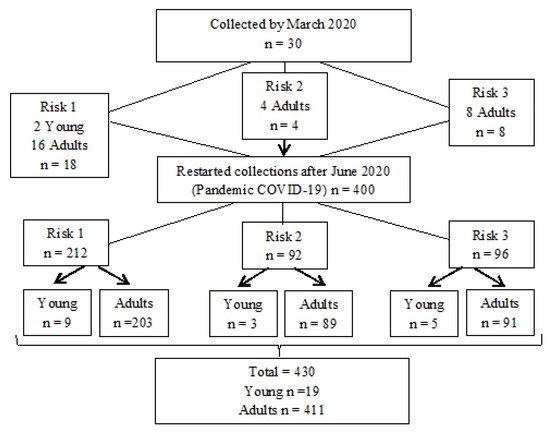
Figure 1
Open AccessArticle
Particle Morphology and Elemental Analysis of Lung Tissue from Post-9/11 Military Personnel with Biopsy-Proven Lung Disease
Int. J. Environ. Res. Public Health 2024, 21(1), 91; https://doi.org/10.3390/ijerph21010091 - 12 Jan 2024
Abstract
The relationship between exposure to inhaled inorganic particulate matter and risk for deployment-related lung disease in military personnel is unclear due in part to difficulties characterizing individual exposure to airborne hazards. We evaluated the association between self-reported deployment exposures and particulate matter (PM)
[...] Read more.
The relationship between exposure to inhaled inorganic particulate matter and risk for deployment-related lung disease in military personnel is unclear due in part to difficulties characterizing individual exposure to airborne hazards. We evaluated the association between self-reported deployment exposures and particulate matter (PM) contained in lung tissue from previously deployed personnel with lung disease (“deployers”). The PM in deployer tissues was compared to normal lung tissue PM using the analytical results of scanning electron microscopy and inductively coupled plasma mass spectrometry. The majority of PM phases for both the deployers and the controls were sub-micrometer in size and were compositionally classified as aluminum and zirconium oxides, carbonaceous particles, iron oxides, titanium oxides, silica, other silicates, and other metals. The proportion of silica and other silicates was significantly higher in the retained dust from military veterans with biopsy-confirmed deployment-related lung disease compared to the control subjects. Within the deployer population, those who had combat jobs had a higher total PM burden, though the difference was not statistically significant. These findings have important implications for understanding the role of inhaled inorganic dusts in the risk for lung injury in previously deployed military veterans.
Full article
(This article belongs to the Special Issue The 2nd Edition of Air Pollution: Occupational Exposure and Public Health)
►▼
Show Figures

Figure 1
Open AccessReview
How Is Telehealth Currently Being Utilized to Help in Hypertension Management within Primary Healthcare Settings? A Scoping Review
by
, , , , , , , , , and
Int. J. Environ. Res. Public Health 2024, 21(1), 90; https://doi.org/10.3390/ijerph21010090 (registering DOI) - 12 Jan 2024
Abstract
Telehealth has improved patient access to healthcare services and has been shown to have a positive impact in various healthcare settings. In any case, little is understood regarding the utilization of telehealth in hypertension management in primary healthcare (PHC) settings. This study aimed
[...] Read more.
Telehealth has improved patient access to healthcare services and has been shown to have a positive impact in various healthcare settings. In any case, little is understood regarding the utilization of telehealth in hypertension management in primary healthcare (PHC) settings. This study aimed to identify and classify information about the types of interventions and types of telehealth technology in hypertension management in primary healthcare. A scoping review based on PRISMA-ScR was used in this study. We searched for articles in four databases: Pubmed, Scopus, Science Direct, and Embase in English. The selected articles were published in 2013–2023. The data were extracted, categorized, and analyzed using thematic analysis. There were 1142 articles identified and 42 articles included in this study. Regarding the proportions of studies showing varying trends in the last ten years, most studies came from the United States (US) (23.8%), were conducted in urban locations (33.3%), and had a quantitative study approach (69%). Telehealth interventions in hypertension management are dominated by telemonitoring followed by teleconsultation. Asynchronous telehealth is becoming the most widely used technology in managing hypertension in primary care settings. Telehealth in primary care hypertension management involves the use of telecommunications technology to monitor and manage blood pressure and provide medical advice and counselling remotely.
Full article
(This article belongs to the Section Digital Health)
►▼
Show Figures
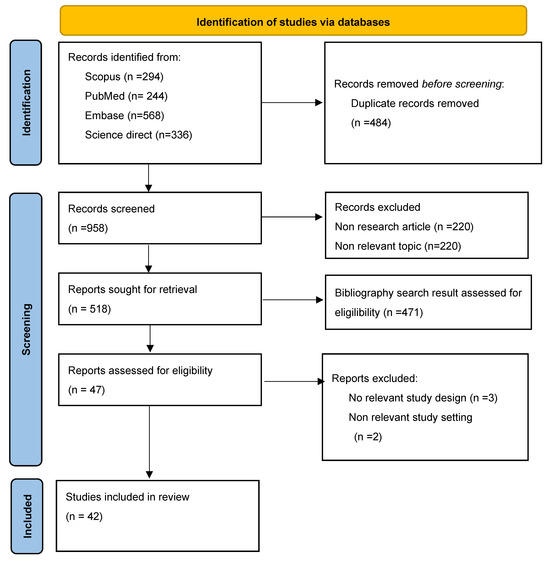
Figure 1
Open AccessArticle
Hypertensive Disorders of Pregnancy and Pre-Pregnancy Hypertension with Subsequent Incident Venous Thromboembolic Events
by
, , , , and
Int. J. Environ. Res. Public Health 2024, 21(1), 89; https://doi.org/10.3390/ijerph21010089 - 12 Jan 2024
Abstract
Hypertensive disorders of pregnancy (HDP) and pre-pregnancy hypertension contribute to maternal morbidity and mortality. We examined the association of HDP and pre-pregnancy hypertension with subsequent venous thromboembolic (VTE) events. The retrospective cohort study included 444,859 women with ≥1 live, singleton birth in South
[...] Read more.
Hypertensive disorders of pregnancy (HDP) and pre-pregnancy hypertension contribute to maternal morbidity and mortality. We examined the association of HDP and pre-pregnancy hypertension with subsequent venous thromboembolic (VTE) events. The retrospective cohort study included 444,859 women with ≥1 live, singleton birth in South Carolina (2004–2016). Hospital and emergency department visit and death certificate data defined incident VTE, HDP, and pre-pregnancy hypertension. Birth certificate data also defined the exposures. Adjusted Cox proportional hazards methods modeled VTE events risk. Of the cohort, 2.6% of women had pre-pregnancy hypertension, 5.8% had HDP, 2.8% had both pre-pregnancy hypertension and HDP (both conditions), and 88.8% had neither condition. The risk of incident VTE events within one year of delivery was higher in women with HDP (hazard ratio [HR] = 1.62, 95% confidence interval [CI]: 1.15–2.29) and both conditions (HR = 2.32, 95% CI: 1.60–3.35) compared to those with neither condition as was the risk within five years for women with HDP (HR = 1.35, 95% CI: 1.13–1.60) and for women with both conditions (HR = 1.82, 95% CI: 1.50–2.20). One- and five-year risks did not differ in women with pre-pregnancy hypertension compared to women with neither condition. Compared to non-Hispanic White (NHW) women with neither condition, the incident VTE event risk was elevated within five years of delivery for NHW (HR = 1.29, 95% CI: 1.02–1.63; HR = 1.59, 95% CI: 1.16–2.17) and non-Hispanic Black (NHB; HR = 1.51, 95% CI: 1.16–2.96; HR = 2.08, 95% CI: 1.62–2.66) women with HDP and with both conditions, respectively, and for NHB women with pre-pregnancy hypertension (HR = 1.50, 95% CI: 1.09–2.07). VTE event risk was highest in women with HDP, and the event rates were higher in NHB women than in NHW women in the same exposure group.
Full article
(This article belongs to the Special Issue Advances in Perinatal Epidemiology and Maternal/Child Health)
►▼
Show Figures

Figure 1
Open AccessArticle
The Association between Perceived Stress, Quality of Life, and Level of Physical Activity in Public School Teachers
by
, , , , , , , and
Int. J. Environ. Res. Public Health 2024, 21(1), 88; https://doi.org/10.3390/ijerph21010088 - 12 Jan 2024
Abstract
Chronic high stress levels related to work impact the quality of life (QoL). Although physical activity improves QoL, it is not clear whether this life study habit could attenuate possible relationships between QoL and stress in public school teachers. The sample for this
[...] Read more.
Chronic high stress levels related to work impact the quality of life (QoL). Although physical activity improves QoL, it is not clear whether this life study habit could attenuate possible relationships between QoL and stress in public school teachers. The sample for this study was made up of 231 teachers from public schools. QoL was assessed using the Short-Form Health Survey and physical activity via Baecke’s questionnaire. A Likert scale assessed stress level perception. Poisson Regression analyzed the association between stress level and QoL domains adjusted for sex, age, and socioeconomic conditions (model 1). In model 2, physical activity level was inserted in addition to model 1. Seven out of eight domains of QoL, except the domain of pain, were associated with high levels of stress (all p < 0.05–model 1). However, in model 2, the associations of the high levels of stress with general health status (p = 0.052) and functional capacity (p = 0.081) domains of QoL were mitigated. Our results indicated that physical activity mitigated the relationship between higher levels of stress and lower perception of general health status and functional capacity domains in secondary public school teachers.
Full article
(This article belongs to the Special Issue Exercise and Health-Related Quality of Life)
►▼
Show Figures

Figure 1
Open AccessArticle
Women Abused: Analysis of Assistance Provided by Urgency Mobile Service
by
, , , , and
Int. J. Environ. Res. Public Health 2024, 21(1), 87; https://doi.org/10.3390/ijerph21010087 - 12 Jan 2024
Abstract
►▼
Show Figures
Considering that reports of violence against women must come after a victim seeks help, the subject matter transcends health-related issues. In Brazil, mobile urgency services (SAMU/SIATE) frequently provide first aid to these women and, to the best of our knowledge, no other research
[...] Read more.
Considering that reports of violence against women must come after a victim seeks help, the subject matter transcends health-related issues. In Brazil, mobile urgency services (SAMU/SIATE) frequently provide first aid to these women and, to the best of our knowledge, no other research has specifically examined the first reaction given to these women. The present study aimed to analyze SAMU/SIATE assistance to abused women in a cross-sectional study of the assistance to assaulted women provided by SIATE and SAMU Maringá/Norte Novo between 2011 and 2020. Women between 20 and 39 years old, non-pregnant, were the main victims, and 19.52% of them have used drugs of some kind. The (ex) partner figured as the perpetrator in 17.35%, but there was no information about this variable in 73.75% of the records. The Chi-square test shows a mortality rate superior to 70% among the severely traumatized victims. This is the first research work to examine the kind of care that SAMU/SIATE offers, and it identifies several weaknesses in its “modus operandi” that may prevent the results from being applied to larger contexts. In addition, further studies on mobile urgent care services in other provinces are required in order to suggest ways to lessen this epidemic.
Full article

Figure 1
Open AccessArticle
Time-Based Stress and Procedural Justice: Can Transparency Mitigate the Effects of Algorithmic Compensation in Gig Work?
Int. J. Environ. Res. Public Health 2024, 21(1), 86; https://doi.org/10.3390/ijerph21010086 - 11 Jan 2024
Abstract
The gig economy has led to a new management style, using algorithms to automate managerial decisions. Algorithmic management has aroused the interest of researchers, particularly regarding the prevalence of precarious working conditions and the health issues related to gig work. Despite algorithmically driven
[...] Read more.
The gig economy has led to a new management style, using algorithms to automate managerial decisions. Algorithmic management has aroused the interest of researchers, particularly regarding the prevalence of precarious working conditions and the health issues related to gig work. Despite algorithmically driven remuneration mechanisms’ influence on work conditions, few studies have focused on the compensation dimension of algorithmic management. We investigate the effects of algorithmic compensation on gig workers in relation to perceptions of procedural justice and time-based stress, two important predictors of work-related health problems. Also, this study examines the moderating effect of algorithmic transparency in these relationships. Survey data were collected from 962 gig workers via a research panel. The results of hierarchical multiple regression analysis show that the degree of exposure to algorithmic compensation is positively related to time-based stress. However, contrary to our expectations, algorithmic compensation is also positively associated with procedural justice perceptions and our results indicate that this relation is enhanced at higher levels of perceived algorithmic transparency. Furthermore, transparency does not play a role in the relationship between algorithmic compensation and time-based stress. These findings suggest that perceived algorithmic transparency makes algorithmic compensation even fairer but does not appear to make it less stressful.
Full article
(This article belongs to the Special Issue The Paradox of Occupational Health and Safety in the New World of Work)
►▼
Show Figures
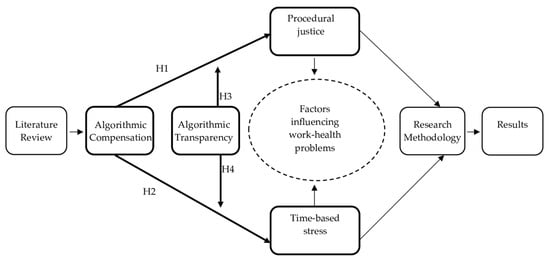
Figure 1
Open AccessCommentary
Strong Born—A First of Its Kind National FASD Prevention Campaign in Australia Led by the National Aboriginal Community Controlled Health Organisation (NACCHO) in Collaboration with the Aboriginal Community Controlled Health Organisations (ACCHOs)
Int. J. Environ. Res. Public Health 2024, 21(1), 85; https://doi.org/10.3390/ijerph21010085 - 11 Jan 2024
Abstract
The Strong Born Campaign (2022–2025) was launched by the National Aboriginal Community Controlled Health Organisation (NACCHO) in 2023. Strong Born is the first of its kind national Aboriginal and Torres Strait Islander health promotion campaign to address Fetal Alcohol Spectrum Disorder (FASD) within
[...] Read more.
The Strong Born Campaign (2022–2025) was launched by the National Aboriginal Community Controlled Health Organisation (NACCHO) in 2023. Strong Born is the first of its kind national Aboriginal and Torres Strait Islander health promotion campaign to address Fetal Alcohol Spectrum Disorder (FASD) within Australia. Strong Born was developed to address a longstanding, significant gap in health promotion and sector knowledge on FASD, a lifelong disability that can result from alcohol use during pregnancy. Utilizing a strengths-based and culturally sound approach, NACCHO worked closely with the Aboriginal Community Controlled Health Organisations (ACCHOs) to develop the campaign through co-design, as described in this paper. Since its inception, the ACCHOs have continually invested in driving change towards improvements in Aboriginal health determinants and health promotion. The Strong Born Campaign developed culturally safe health promotion tool kits designed for the community and health sector staff and also offered communities the opportunity to apply for FASD Communications and Engagement Grants to engage in local campaign promotion. The tool kits have been disseminated to 92 ACCHOs across Australia. This paper describes the development of the Strong Born Campaign and activities following its launch in February 2023 from an Indigenous context within Australia, as described by NACCHO.
Full article
(This article belongs to the Special Issue First Nation, Indigenous and Aboriginal Perspectives of Health Promotion and Wellbeing)
►▼
Show Figures

Figure 1
Open AccessArticle
Student’s Self-Reported Experience of Soundscape: The Link between Noise, Psychological and Physical Well-Being
by
, , , , , and
Int. J. Environ. Res. Public Health 2024, 21(1), 84; https://doi.org/10.3390/ijerph21010084 - 11 Jan 2024
Abstract
►▼
Show Figures
Extensive research has shown that noise has detrimental effects on learning in classrooms, yet schools remain noisy environments. In addition, little is known about the students’ insight into their subjective reaction to noise. Students’ awareness of noise, as well as their perception of
[...] Read more.
Extensive research has shown that noise has detrimental effects on learning in classrooms, yet schools remain noisy environments. In addition, little is known about the students’ insight into their subjective reaction to noise. Students’ awareness of noise, as well as their perception of its effects on their affective and bodily states, remain unanswered. In the current study, the self-reported experience of noise and reaction towards noise, which was collected by way of a questionnaire, was assessed for 408 students in primary and secondary schools in Québec. Results suggest that about half of the students experience affective and bodily reactions to noise, and students who report having a negative affective reaction to noise are also more prone to report feeling this noise in their bodies. The results of this study offer a comprehensive picture of the students’ subjective (affective and bodily) state in relation to noise in schools.
Full article
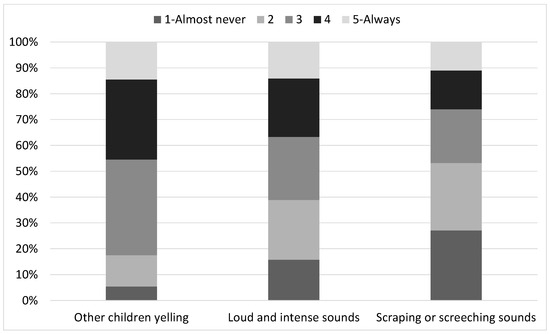
Figure 1
Open AccessArticle
Food and Alcohol Disturbance in High School Adolescents: Prevalence, Characteristics and Association with Problem Drinking and Eating Disorders
by
, , , , , , , , , , , , , , and
Int. J. Environ. Res. Public Health 2024, 21(1), 83; https://doi.org/10.3390/ijerph21010083 - 11 Jan 2024
Abstract
Food and alcohol disturbance (FAD) is characterized by the association of alcohol use with compensatory behaviors such as restricting calories, physical activity and purging. Despite not being part of the current nosography, research has grown in the past 10 years, mostly on college
[...] Read more.
Food and alcohol disturbance (FAD) is characterized by the association of alcohol use with compensatory behaviors such as restricting calories, physical activity and purging. Despite not being part of the current nosography, research has grown in the past 10 years, mostly on college students’ samples. In this study, we aim to describe the prevalence, characteristics and association of FAD with problem drinking (PD) and eating disorder risk (EDR) in a sample of Italian high school students. Participants were 900 high school students (53.6% males; mean age = 16.22) that were administered standardized questionnaires. Students who screened positive for PD, EDR and both were, respectively, 17.3%, 5.9% and 1.3%. Approximately one out four students reported FAD behaviors, mostly to control weight and by restricting calories, with higher prevalence and severity among those who screened positive for PD. Purging behaviors were rare overall (15.5%), but significantly more frequent in participants who screened positive for both PD and EDR (41.7%). FAD was more strongly associated with alcohol use severity than with ED symptom severity across all subgroups. FAD behaviors appear to be common in the Italian high school population and more strongly associated with PD. Future studies should investigate FAD’s impact on adolescents’ functioning and possible early interventions.
Full article
(This article belongs to the Special Issue Students’ Education and Mental Health)
Open AccessArticle
Concussion-Related Decision-Making by Certified Athletic Trainers: Implications for Concussion Prevention and Care
by
, , , , , and
Int. J. Environ. Res. Public Health 2024, 21(1), 82; https://doi.org/10.3390/ijerph21010082 - 11 Jan 2024
Abstract
Concussions are a common sport-related injury that require appropriate initial care. Athletic trainers, often a primary source of healthcare for student-athletes, are key individuals involved in initial concussion diagnostic and management decisions. Challenges exist within the athletic environment that may hinder the consistency,
[...] Read more.
Concussions are a common sport-related injury that require appropriate initial care. Athletic trainers, often a primary source of healthcare for student-athletes, are key individuals involved in initial concussion diagnostic and management decisions. Challenges exist within the athletic environment that may hinder the consistency, efficacy, and/or effectiveness of concussion-related decision-making by athletic trainers, thereby impacting secondary concussion prevention and patient health. The purpose of this study was to identify factors that impact the intentions of athletic trainers to make appropriate concussion-related decisions under various circumstances. Overall, 1029 participants completed a survey examining educational precursors (quantity and quality of healthcare communication educational focus), demographic precursors (age, gender, educational degree, and employment setting), theory-based mediators (attitudes, perceived norms, and personal agency), and external mediators (knowledge, salience, and communication/collaboration practices) on appropriate concussion-related decision-making intentions. Data were analyzed using a two-step structural equation modeling approach. Quality of healthcare communication educational focus indirectly impacted appropriate concussion-related decision-making intentions via perceived behavioral control and communication/collaboration practices. Additionally, several factors impacted intentions to make appropriate concussion-related decisions directly including employment setting, self-efficacy, and general attitudes towards decision-making and concussions. Concussion prevention is aided by the initial and appropriate action taken by a healthcare professional to reduce immediate consequences; however, this action may be influenced by stakeholder relationships. These influential factors of decision-making may place athletes at further injury risk and negatively impact overall athlete health. As such, a sound theoretical framework incorporating the complexity of factors that may influence decision-making is needed.
Full article
(This article belongs to the Section Sport and Health)
►▼
Show Figures

Figure 1
Open AccessArticle
Adverse Childhood Experiences and Depression among Homeless Young Adults: A Social Determinants of Health Perspective
by
, , , , , , and
Int. J. Environ. Res. Public Health 2024, 21(1), 81; https://doi.org/10.3390/ijerph21010081 - 11 Jan 2024
Abstract
Homelessness is a pervasive issue in the United States that presents significant challenges to public health. Homeless young adults (HYAs) are at particular risk for increased incidence and severity of depression. Using primary survey data (n = 205) collected in the Phoenix
[...] Read more.
Homelessness is a pervasive issue in the United States that presents significant challenges to public health. Homeless young adults (HYAs) are at particular risk for increased incidence and severity of depression. Using primary survey data (n = 205) collected in the Phoenix Metropolitan Area, Arizona, from June to August 2022, this study aims to examine the relationship between adverse childhood experiences (ACEs) and depression among HYAs. We adopted the ACEs 10-item scale to measure childhood traumatic experiences, whereas depression was measured by using a PHQ-4 depression scale and diagnosed depression. Regression models were conducted to test the relationships between ACEs and depression outcomes while controlling for the covariates at the individual, interpersonal, and socioeconomic/living environment levels. The average PHQ-4 score was 5.01 (SD = 3.59), and 59.69% of HYAs reported being diagnosed previously with depression. The mean ACEs score was 5.22 out of 10. Other things being equal, for every one unit increase in ACEs scores, the odds of being diagnosed with depression increased by 11.5%, yet it was not statistically significant, while the PHQ-4 score increased by 0.445 (p < 0.001). Overall, HYAs were disproportionately affected by depression. This study elucidates the complex relationship between ACEs and depression among HYAs.
Full article
(This article belongs to the Special Issue Substance Use, Mental Health, and Other Issues Related to Homelessness: Building the Evidence for Best Practices to End Housing Instability)
Open AccessCorrection
Correction: Suh Nchang et al. Knowledge about Asymptomatic Malaria and Acceptability of Using Artemisia afra Tea among Health Care Workers (HCWs) in Yaoundé, Cameroon: A Cross-Sectional Survey. Int. J. Environ. Res. Public Health 2023, 20, 6309
by
, , , , , , , , , , and
Int. J. Environ. Res. Public Health 2024, 21(1), 80; https://doi.org/10.3390/ijerph21010080 - 11 Jan 2024
Abstract
Error in Table [...]
Full article
Open AccessReview
Leveraging Emerging Technologies to Expand Accessibility and Improve Precision in Rehabilitation and Exercise for People with Disabilities
Int. J. Environ. Res. Public Health 2024, 21(1), 79; https://doi.org/10.3390/ijerph21010079 - 10 Jan 2024
Abstract
Physical rehabilitation and exercise training have emerged as promising solutions for improving health, restoring function, and preserving quality of life in populations that face disparate health challenges related to disability. Despite the immense potential for rehabilitation and exercise to help people with disabilities
[...] Read more.
Physical rehabilitation and exercise training have emerged as promising solutions for improving health, restoring function, and preserving quality of life in populations that face disparate health challenges related to disability. Despite the immense potential for rehabilitation and exercise to help people with disabilities live longer, healthier, and more independent lives, people with disabilities can experience physical, psychosocial, environmental, and economic barriers that limit their ability to participate in rehabilitation, exercise, and other physical activities. Together, these barriers contribute to health inequities in people with disabilities, by disproportionately limiting their ability to participate in health-promoting physical activities, relative to people without disabilities. Therefore, there is great need for research and innovation focusing on the development of strategies to expand accessibility and promote participation in rehabilitation and exercise programs for people with disabilities. Here, we discuss how cutting-edge technologies related to telecommunications, wearables, virtual and augmented reality, artificial intelligence, and cloud computing are providing new opportunities to improve accessibility in rehabilitation and exercise for people with disabilities. In addition, we highlight new frontiers in digital health technology and emerging lines of scientific research that will shape the future of precision care strategies for people with disabilities.
Full article
(This article belongs to the Special Issue Mobile Health and Mobile Rehabilitation for People with Disabilities: 2nd Edition)
►▼
Show Figures
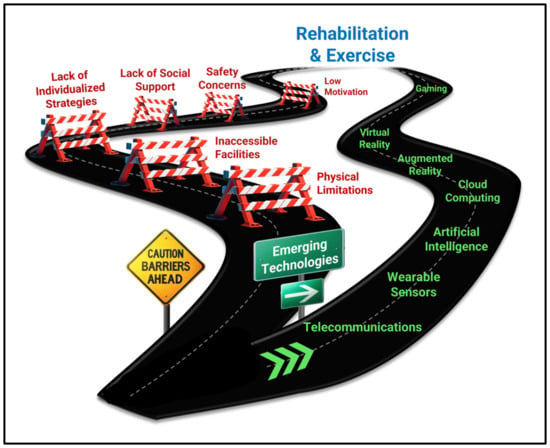
Figure 1
Open AccessArticle
Socioeconomic, Demographic, and Environmental Factors May Inform Malaria Intervention Prioritization in Urban Nigeria
by
, , , , , and
Int. J. Environ. Res. Public Health 2024, 21(1), 78; https://doi.org/10.3390/ijerph21010078 - 10 Jan 2024
Abstract
Urban population growth in Nigeria may exceed the availability of affordable housing and basic services, resulting in living conditions conducive to vector breeding and heterogeneous malaria transmission. Understanding the link between community-level factors and urban malaria transmission informs targeted interventions. We analyzed Demographic
[...] Read more.
Urban population growth in Nigeria may exceed the availability of affordable housing and basic services, resulting in living conditions conducive to vector breeding and heterogeneous malaria transmission. Understanding the link between community-level factors and urban malaria transmission informs targeted interventions. We analyzed Demographic and Health Survey Program cluster-level data, alongside geospatial covariates, to describe variations in malaria prevalence in children under 5 years of age. Univariate and multivariable models explored the relationship between malaria test positivity rates at the cluster level and community-level factors. Generally, malaria test positivity rates in urban areas are low and declining. The factors that best predicted malaria test positivity rates within a multivariable model were post-primary education, wealth quintiles, population density, access to improved housing, child fever treatment-seeking, precipitation, and enhanced vegetation index. Malaria transmission in urban areas will likely be reduced by addressing socioeconomic and environmental factors that promote exposure to disease vectors. Enhanced regional surveillance systems in Nigeria can provide detailed data to further refine our understanding of these factors in relation to malaria transmission.
Full article
(This article belongs to the Section Infectious Disease Epidemiology)
►▼
Show Figures
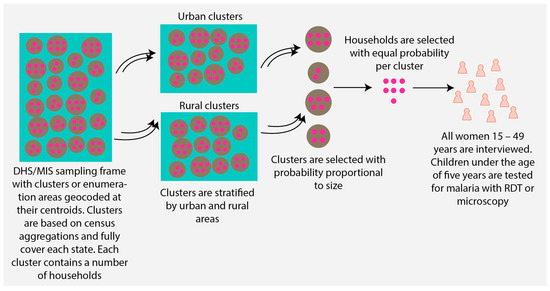
Figure 1
Open AccessArticle
Examining Coping Strategies and Their Relation with Anxiety: Implications for Children Diagnosed with Cancer or Type 1 Diabetes and Their Caregivers
by
, , , , , and
Int. J. Environ. Res. Public Health 2024, 21(1), 77; https://doi.org/10.3390/ijerph21010077 - 10 Jan 2024
Abstract
The onset of chronic diseases in childhood represents a stressful event for both young patients and their caregivers. In this context, coping strategies play a fundamental role in dealing with illness-related challenges. Although numerous studies have explored coping strategies employed by parents of
[...] Read more.
The onset of chronic diseases in childhood represents a stressful event for both young patients and their caregivers. In this context, coping strategies play a fundamental role in dealing with illness-related challenges. Although numerous studies have explored coping strategies employed by parents of children with chronic diseases, there remains a gap in the understanding of children’s coping strategies and their correlation with their and their parents’ anxiety. This study aims to investigate coping strategies and their interaction with anxiety in groups of young patients with cancer, type 1 diabetes (T1D), and their respective caregivers, in comparison to healthy children and caregivers. We recruited a total of 61 control children, 33 with cancer, and 56 with T1D, 7 to 15 years old, along with their mothers. Each participant completed a customized survey and standardized questionnaires. No significant differences emerged in coping strategies used by children among the different groups. However, when examining the association between coping strategy and anxiety, we found specific patterns of interaction between children’s use of coping strategies and their and their mothers’ anxiety levels. This study underscores the importance of an illness-specific approach to gain deeper insights into this topic and develop targeted interventions aimed at enhancing the psychological well-being of these vulnerable populations.
Full article
(This article belongs to the Special Issue Advances in Children’s Health and Well-Being)
►▼
Show Figures
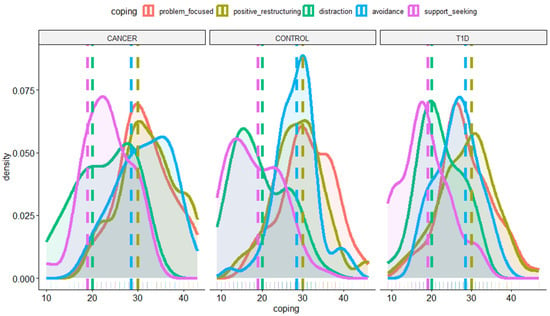
Figure 1

Journal Menu
► ▼ Journal Menu-
- IJERPH Home
- Aims & Scope
- Editorial Board
- Reviewer Board
- Topical Advisory Panel
- Instructions for Authors
- Special Issues
- Topics
- Sections & Collections
- Article Processing Charge
- Indexing & Archiving
- Editor’s Choice Articles
- Most Cited & Viewed
- Journal Statistics
- Journal History
- Journal Awards
- Society Collaborations
- Editorial Office
Journal Browser
► ▼ Journal Browser-
arrow_forward_ios
Forthcoming issue
arrow_forward_ios Current issue - Vol. 21 (2024)
- Vol. 20 (2023)
- Vol. 19 (2022)
- Vol. 18 (2021)
- Vol. 17 (2020)
- Vol. 16 (2019)
- Vol. 15 (2018)
- Vol. 14 (2017)
- Vol. 13 (2016)
- Vol. 12 (2015)
- Vol. 11 (2014)
- Vol. 10 (2013)
- Vol. 9 (2012)
- Vol. 8 (2011)
- Vol. 7 (2010)
- Vol. 6 (2009)
- Vol. 5 (2008)
- Vol. 4 (2007)
- Vol. 3 (2006)
- Vol. 2 (2005)
- Vol. 1 (2004)
Highly Accessed Articles
Latest Books
E-Mail Alert
News
10 January 2024
International Journal of Environmental Research and Public Health Papers Cited in the News in Q4 of 2023
International Journal of Environmental Research and Public Health Papers Cited in the News in Q4 of 2023

2 January 2024
MDPI Insights: The CEO's Letter #7 - Nobel Laureates Entrust MDPI with Their Research
MDPI Insights: The CEO's Letter #7 - Nobel Laureates Entrust MDPI with Their Research
Topics
Topic in
Healthcare, IJERPH, JCM, JPM, Applied Sciences, Technologies
Smart Healthcare: Technologies and Applications
Topic Editors: Gang Kou, Shuai Ding, Li Luo, Tian Lu, Yogesan KanagasingamDeadline: 20 January 2024
Topic in
Children, Dentistry Journal, IJERPH, Nutrients, Oral
Oral Health Management for Children, Adolescents, and Adults, 2nd Volume
Topic Editors: Daisuke Ekuni, Hiroaki InabaDeadline: 1 February 2024
Topic in
Adolescents, Children, Healthcare, IJERPH, JCM, Nutrients, Behavioral Sciences, Social Sciences
Socio-Environmental Determinants of the Disparities in Health Behaviors among Minority Youth
Topic Editors: Ryan D. Burns, You FuDeadline: 29 February 2024
Topic in
Applied Sciences, Bioengineering, Healthcare, IJERPH, JCM, AI
Artificial Intelligence in Public Health: Current Trends and Future Possibilities
Topic Editors: Daniele Giansanti, Giovanni CostantiniDeadline: 31 March 2024

Conferences
Special Issues
Special Issue in
IJERPH
Scientific Advances and Future Directions of Chronic Pain: Prevalence, Impact on Daily Life, and Treatment
Guest Editors: Frédéric Telliez, Nathalie RousselDeadline: 20 January 2024
Special Issue in
IJERPH
The State of the Art of Health Data Science: Precision Medicine, Predictive Models and Clinical Decision Support Systems
Guest Editors: Madhan Balasubramanian, Benjumin HsuDeadline: 30 January 2024
Special Issue in
IJERPH
Cannabis and Addiction Pathophysiology Epidemiology and Multi-Omics Genotoxicity as Relates to Carcinogenicity, Teratology and Aging Acceleration
Guest Editors: Stuart Reece, Gary HulseDeadline: 4 February 2024
Special Issue in
IJERPH
Maternal and Child Health and Nutrition in Latin American Populations
Guest Editor: Ana Cristina LindsayDeadline: 29 February 2024
Topical Collections
Topical Collection in
IJERPH
Public Health Surveillance and Infectious Disease Control
Collection Editors: Giovanni Improta, Emma Montella, Giovanni Boccia, Ilaria Loperto
Topical Collection in
IJERPH
Epidemiological Lifestyle Analysis and Infection Prevention in Public Health
Collection Editors: Mariusz Gujski, Mateusz Jankowski
Topical Collection in
IJERPH
Lean Six Sigma in Healthcare
Collection Editors: Giovanni Improta, Massimo Martorelli, Alfonso Maria Ponsiglione, Antonio Gloria






.jpg)








